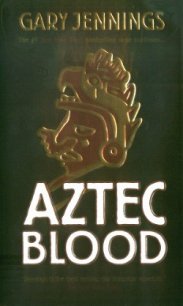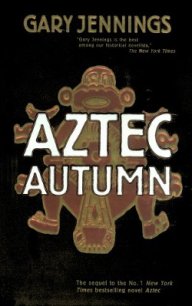Aztec - Jennings Gary (книги хорошем качестве бесплатно без регистрации TXT) 📗
We were more of a menace to the native creatures than most of them were to us. During our month in the jungle, Blood Glutton's arrows provided us with several meals of jaleb, iguana, capybara, and tapir. Edible, my lords? Oh, quite. The meat of the jaleb is indistinguishable from that of the opossum; iguana flesh is white and flaky like that of the sea crayfish you call lobster; capybara tastes like the most tender rabbit; and tapir meat is very similar to pork.
The only large animal we had to fear was the jaguar. In those southern jungles the cats are more numerous than in all the temperate lands together. Of course, only a jaguar too old or too ill to hunt more nimble prey will attack a full-grown human without provocation. But little Cozcatl might have been a temptation, so we never let him out of a protective group of us adults. And, when we marched through the jungle in single file, Blood Glutton made us all carry our spears held vertically, the blades pointing straight up above our heads, because the jungle jaguar's favored way of hunting is simply to loll on a tree branch and wait to drop on some unwary victim passing below.
Blood Glutton had bought in Chiapan two items for each of us and I do not think we could have survived in the jungle without them. One was a light and delicately woven mosquito netting which we often draped over ourselves even during the daylight marches, so pestilent were the flying insects. The other item was a kind of bed called a gishe, simply a net of slender rope, woven in a sort of beanpod shape, which could be slung between any two close-set trees. It was so much more comfortable than a pallet that I carried a gishe on all my later travels, for use wherever there were trees to support it.
Our elevated beds put us out of the reach of most snakes, and the mantles of netting at least discouraged things like bloodsucker bats, scorpions, and other vermin of little initiative. But nothing could keep the more ambitious creatures—ants, for instance—from using our gishe ropes for a bridge and then tunneling under the nets. If ever you wish to know what the bite of a jungle fire ant feels like, reverend friars, hold one of Master Xibalba's crystals between the sun and your bare skin.
And there were even worse things. One morning I awoke feeling something oppressive on my chest, and cautiously lifted my head to see a thick, hairy, black hand laid there, a hand nearly twice the span of my own. "If I am being pawed by a monkey," I thought drowsily, "it is an unheard-of new breed, bigger than any man." Then I realized that the heavy thing was a bird-eating tarantula, and that there was only flimsy mosquito cloth between me and its sickle jaws. On no other morning of my life have I ever arisen with such alacrity, getting out of my coverings and as far as the ashes of the campfire all in a single bound, trailing a yell that brought everyone else to his feet almost as urgently.
But not everything in the jungle is ugly or menacing or pestilential. For a traveler who takes reasonable precautions, the jungle can be hospitable and beautiful as well. Edible game animals are easy to secure; many of the plants make nourishing cooked greens; even some of the ghastliest fungoid growths are delicious to eat. There is one arm-thick liana that looks as crusty and dry as baked clay; but cut off an arm's-length of it and inside you find it as porous as a bees' comb; tilt it over your head and it trickles out a generous drink of the freshest, sweetest, coolest water. As for the jungle's beauty, I cannot begin to describe the brilliant flowers I saw there, except to say that, of their thousands of thousands, I remember no two of similar shape and coloring.
The most gorgeous birds we saw were the numerous varieties of the quetzal, vividly colored, distinctively crested and plumed. But only infrequently did we glimpse the most magnificent and treasured bird of all, the quetzal tototl, the one with emerald tail feathers as long as a man's legs. That bird is as proud of its plumage as any nobleman who wears it later. Or so I was told by a Maya girl named Ix Ykoki. She said that the quetzal tototl builds a globular nest unique among birds' nests because it has two doorway holes. Thus the bird can enter through one and depart through the other without having to turn around inside and risk breaking one of those splendid tail plumes. Also, said Ix Ykoki, the quetzal tototl feeds only on small fruits and berries, and it snatches those from trees and vines as it flies past, and it eats them on the wing, rather than perched comfortably on a bough, to assure that the juice does not drip and stain those pendant plumes.
Since I have mentioned the girl Ix Ykoki, I might as well remark that, in my opinion, not she nor the other resident human beings added appreciably to the beauty of those jungle lands.
According to all the legends, the Maya once had a far richer, mightier, and more resplendent civilization than we Mexica ever approached, and the remaining ruins of their onetime cities are powerful evidence in support of those legends. There is also evidence that the Maya may have learned all their arts and skills directly from the peerless Tolteca, before those Master Artisans went away. For one thing, the Maya worship many of the same Tolteca gods that we Mexica also later appropriated: The beneficent Feathered Serpent whom we call Quetzalcoatl they call Kukulkan. The rain god whom we call Tlaloc they call Chak.
On that expedition and later ones, I have seen the remains of many of the Maya cities, and no one could deny that they must have been overwhelming in their prime. In their empty plazas and courtyards can still be seen admirable statues and carved stone panels and richly ornamented facades and even pictures from which the lively colors have not faded in all the sheaves upon sheaves of years since they were painted. I particularly noticed one detail of the Maya buildings—door openings gracefully upward-tapered in shape—that our modern architects have never yet tried or perhaps been able to imitate.
It took countless Maya artists and artisans many generations and much labor and loving care to build and beautify those cities. Now they stand empty, forsaken, forlorn. There is no mark of their having been besieged by enemy armies, or of their having suffered even the slightest of natural disasters, yet their thousands of inhabitants for some reason abandoned every one of them. And the descendants of those inhabitants are now so ignorant and uncaring of their own history that they cannot tell—they cannot even venture a plausible guess—why their ancestors left those cities, why the jungle was allowed to reclaim and overthrow them. Today's Maya cannot even tell why they, who should have inherited all that grandeur, now live resignedly in wretched grass-shack villages on the outskirts of those ghost cities.
The once vast but unified dominion of the Maya, formerly ruled from a capital city called Mayapan, has long been fractured into geographically different northern and southern divisions. I and my companions were then traveling in the more worthwhile part: the luxuriant jungle country called Tamoan Chan, Land of the Mists, which stretches limitlessly eastward from the boundaries of the Chiapa territory. To the north, where I traveled on a later occasion, is the great peninsula jutting into the northern ocean, the first place your Spanish explorers set foot in these lands. I should have thought that, after one look at those uninviting barrens, they would have gone home and come here no more.
Instead, they gave that land a name which is even more absurd than your Cow-Horn for Quaunahuac or Tortilla for what used to be Texcala. When those first Spaniards landed and asked, "What is this place called?" the inhabitants, never having heard Spanish before, quite naturally replied, "Yectetan," which means only "I do not understand you." Those explorers made of that the name Yucatan, and I suppose the peninsula will be called so forever. But I should not laugh. The Maya's own name for that region—Uluumil Kutz, or Land of Plenty—is just as ridiculous, or possibly ironic, since the greater part of that peninsula is pitifully unfruitful and unsuited for human habitation.




